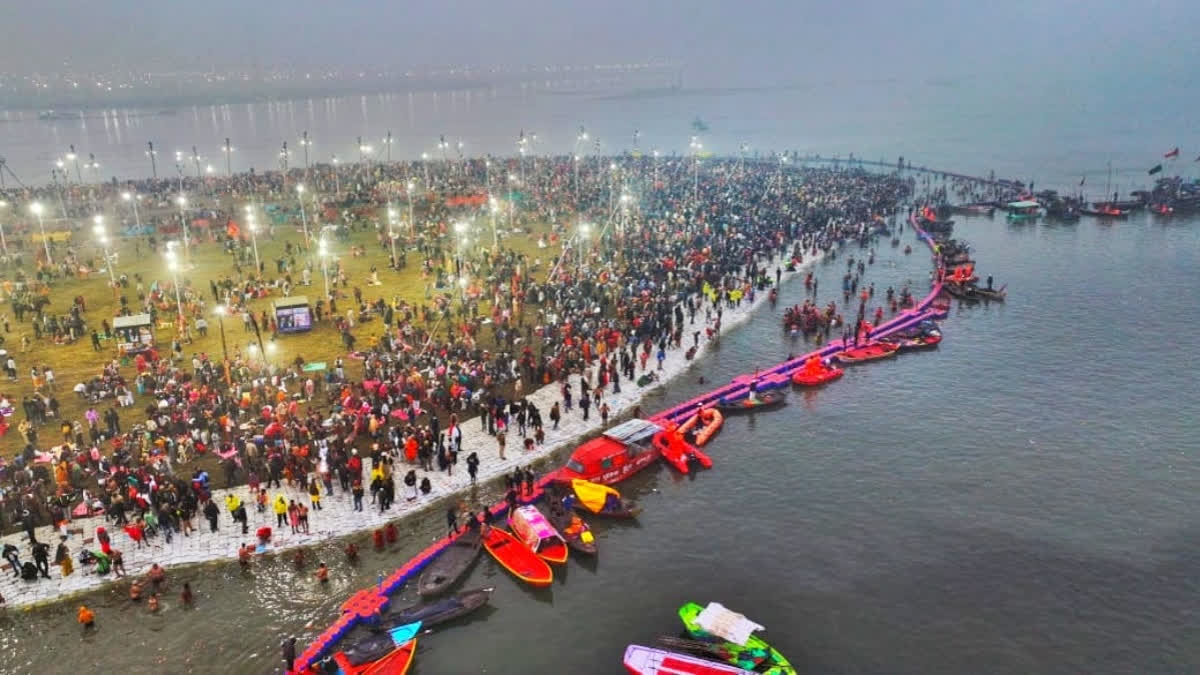Prayagraj:The Mahakumbh Mela 2025, currently underway, has not only drawn millions of pilgrims to Prayagraj but has also ushered in a wave of transformative infrastructure development.
From widened roads and modernised transportation systems to upgraded sanitation facilities and beautified public spaces, the city has undergone a remarkable facelift. Residents, who once struggled with inadequate urban amenities, now celebrate the benefits of these lasting improvements, which have turned Prayagraj into a model for sustainable urban growth driven by cultural and religious events.
Residents of the city say that there have been many infrastructural changes from the last Kumbh Mela and the ongoing one. "Earlier, old roads were used to lead to the venue of the Mela," RS Shukla, a retired bank officer and a long-time resident of the city, told ETV Bharat citing one such example of infrastructure development. "But, this time a new road has been constructed from Allahabad Polytechnic that leads directly to the site of the Mela."
Shukla said that roads have been improved and new flyovers have come. "Roadside encroachments have been removed and roads have been widened," he said, citing the Walchand Chouraha (square) and Murfordganj Chouraha as examples. Shukla said that to streamline road traffic in the Civil Lines area, all traffic crossings have been turned into roundabouts.
It is worth mentioning here that to accommodate over 400 million pilgrims from across the world, the urban development department of the state went on a massive infrastructure development overdrive worth over Rs 7,000 crore. This funding encompasses 549 projects focusing on infrastructure, sanitation, and logistics, including the construction of a massive 4,000-hectare tent city, effectively creating a temporary 76th district of the state.
Roads leading to key locations in the city have been widened and resurfaced. Bridges and flyovers have been constructed to reduce congestion. Near the Allahabad High Court, a new flyover has been built to ease traffic coming from Kanpur. Additionally, the Ganga Expressway, a 594 km long, six-lane (expandable to eight) greenfield expressway connecting Meerut to Prayagraj, is under construction further facilitating access to the city.
Shukla said that, earlier, there were only three railway stations in the city leading to traffic chaos. Now, there are as many as eight railway stations in the city. These are: Prayagraj Junction, Prayag, Prayag Ghat, Prayagraj City, Subedarganj, Naini, Jhusi and Chiwaki.
A major focus of the development plan is ensuring access to clean water and effective sanitation for both residents and visitors. Installation of water ATMs and advanced purification systems ensures safe drinking water across the city. Over 150,000 modern temporary toilets have been installed, complemented by mobile sanitation units and waste treatment systems.
“Earlier there was not even the concept of sewage treatment in Allahabad (as Prayagraj was earlier known)," Shukla said. "My house is 45 years old. But it was only in the last four to five years, sewage treatment facilities have been introduced near my house."
He said that, till now, around 80 to 90 per cent sewage treatment facilities in the city have been completed. This will stop the flow of dirty water into the Ganga because of which the residents had to bear with a foul smell.
The installation of water ATMs and advanced purification systems has ensured safe drinking water across the city. Over 150,000 modern temporary toilets have been installed, complemented by mobile sanitation units and waste treatment systems. To accommodate millions of pilgrims and visitors, significant investments have been made in temporary and permanent housing.
Apart from the 4,000-hectare tent city, equipped with essential amenities such as power, water, and markets, existing hotels, ashrams, and guesthouses have been upgraded, while new affordable housing projects have been launched for locals. Prayagraj is also embracing smart city technologies to enhance urban living.
The city is illuminated with energy-efficient LED streetlights, ensuring safety and reducing energy consumption. A network of over 2,700 Artifical Intelligence (AI)-enabled CCTV cameras monitors the city, ensuring security and efficient crowd management. Digital platforms are facilitating real-time updates, crowd control, and emergency response during the Mahakumbh Mela.
Efforts have been made to integrate environmentally sustainable practices into the city’s development. Intensive efforts to clean the Ganga river, including strict waste management protocols and deployment of “Ganga Praharis”, have improved water quality. Parks and green belts have been developed, enhancing the city’s aesthetics and air quality.
Comprehensive healthcare infrastructure has been established to cater to the needs of residents and visitors. Eleven temporary hospitals have been set up to handle medical emergencies during the Mahakumbh Mela. A robust fleet of ambulances equipped with advanced life-support systems is on standby.
The infrastructure development in Prayagraj has brought significant economic and social benefits. Thousands of jobs have been created in construction, sanitation, transportation, and hospitality sectors. Small businesses, artisans, and vendors are benefiting from increased tourism and trade opportunities. Residents now enjoy better roads, cleaner surroundings, and enhanced public amenities.
"It is not just another Kumbh Mela," Vidya Sagar, a biology graduate from Allahabad University said. “It is a boon for Prayagraj. In terms of development, it has given Prayagraj a completely new face." Vidya Sagar said that essential items needed for daily life are available in the Mela area. Temporary railway counters have been set up all over the city for the convenience of visitors.
The transformation of Prayagraj ahead of the Mahakumbh Mela 2025 stands as a testament to how cultural and religious events can serve as catalysts for urban development. With its improved infrastructure, sustainable practices, and smart city features, Prayagraj offers a blueprint for other cities aiming to balance tradition with modernity. The legacy of these efforts will not only benefit the city’s residents but also set a benchmark for future urban planning across India.
"If you have visited Prayagraj one year before the Mahakumbh Mela and again visit one year after the event, you won’t be able to recognise it," Shukla effectively summed up.
